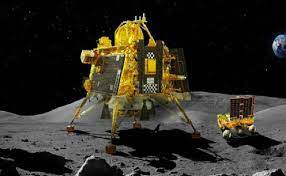To commence this journey into the realm of India’s space exploration endeavors, we must first cast our minds back to a time when India was under the grip of colonial powers. The 1700s saw India subject to colonial rule, a period marked by oppression and subjugation. The belief emerged that the greater the suppression, the more fervent the revolution that would eventually lead to India’s independence.
In 1947, the dream of independence was realized, marking the beginning of a new chapter for the nation. However, this was no easy feat; it was an arduous task that required rebuilding a nation from the fragments left behind by colonial rule. India embarked on a journey of self-discovery and progress across various fields, including science and technology. Notably, it took nearly three decades after gaining independence for India to enter the domain of space exploration.
From Aryabhatta to Chandrayaan: A Rigorous Path
India’s first foray into space came in 1975 when it launched the Aryabhatta satellite. Named after the ancient Indian mathematician, this mission marked India’s initial steps into the vast expanse of space. The Aryabhatta satellite carried out experiments in areas like Aeronomics and Solar physics. In simpler terms, it aimed to study the upper atmosphere, setting the stage for India’s growing interest and capabilities in space technology.
This early space program was made possible through collaboration with the Soviet Union, now known as Russia, which played a pivotal role in India’s journey into space. The Soviet Union not only facilitated the launch of Aryabhatta but also shared valuable knowledge and expertise in space technology and design. This collaboration laid the foundation for India’s future endeavors in the cosmos.
Chandrayaan-2: A Lesson in Perseverance
Fast forward to 2008, when India initiated the Chandrayaan mission, representing a significant milestone in its space exploration efforts. Chandrayaan-2 is the second child of the parental mission “Chandrayaan” which was set up in 2008. The satellite was all set to be launched on 22nd July, 2019 with an aim to study the topography, mineralogy and to study the water ice in the south polar region.
However, fate had other plans. Chandrayaan-2 encountered a critical setback when a non-rectifiable software glitch, rendering it a stagnant and unresponsive satellite. The disappointment reverberated across the nation, as expectations were high.
Yet, there was a silver lining to this setback. The orbiter component of Chandrayaan-2 was equipped with a high-resolution camera, which provided the clear images of the moon’s surface. These images have since been invaluable to scientists, offering a clear view of potential landing sites for future missions.
Chandrayaan-3: A Resilient Comeback
The failure of Chandrayaan-2, though disheartening, ignited a deeper resolve within the Indian Space Research Organisation (ISRO). It became a turning point, prompting ISRO to embark on the Chandrayaan-3 mission. This mission was founded on the principle of learning from failure and rectifying the mistakes that led to the previous mission’s challenges. The goal was to ensure a safe and smooth lunar landing, a feat that had eluded them before.
ISRO took several corrective measures in the development of Chandrayaan-3. One notable adjustment was the reduction of the mission’s cost, a shift from ₹960 crore to ₹761 crore, making it a more cost-effective endeavor. Furthermore, the mission was equipped with a lunar lander named “Vikram” and a lunar rover named “Pragyan.” The orbiter component was replaced with a propulsion module, and new experimental payloads were assigned to it. These changes aimed to improve the mission’s chances of success.
Chandrayaan-3’s landing site was strategically chosen at 69.36°S, 32.34°E, a different location from Chandrayaan-2. Besides that , the mission’s lifespan was set for 3 to 6 months, in contrast to Chandrayaan-2’s one-year mission. Chandrayaan-3 was not designed to return to Earth, meaning it would remain on the moon’s surface.
Significance of Chandrayaan-3:
Exploring the Unexplored
Chandrayaan-3 held the distinction of being designed to make a historic landing on the moon’s South Pole. This achievement would mark India as the first nation to accomplish such a feat. The choice of the moon’s South Pole is strategic due to its minimal exposure to the sun. This positioning enhances the scientific potential of the mission, allowing for in-depth analysis and exploration.
Moreover, the successful launch of Chandrayaan-3 upraised India’s standing in the global space arena. It positioned India alongside space exploration giants such as the United States, Russia, and China. While many nations had attempted lunar missions, few had succeeded. Even Russia’s attempt with “Luna-25” to launch a satellite to the lunar surface had fallen short, making India the first nation to land a satellite on the moon’s South Pole.
A Leap Forward in the Space Sector
Chandrayaan-3’s triumphant launch signified a significant leap forward in India’s space sector. It served as a catalyst for increased government investment in private space launches and satellite-based enterprises. The impact was widespread, as it was expected to boost India’s share of the global space market by a huge margin within the next decade.
This holds the potential to shape India’s future by enhancing its global reputation as a leading player in space exploration. It opens the door to collaborative missions and partnerships with other nations involved in space exploration. Beyond exploration, the mission contributes to technological advancements in sectors such as communication and engineering. Importantly, it inspires the youth to pursue careers in Science, Technology, Engineering, and Mathematics (STEM), fostering a new generation of innovators and scientists.
Job Creation and Economic Impact
The successful launch of Chandrayaan-3 holds promise beyond the realm of space exploration. It ushers in opportunities for job creation, particularly within the STEM fields. India’s need for a skilled workforce has gained paramount importance, especially in the post-pandemic era. Chandrayaan-3’s success can generate a diverse array of employment opportunities, supporting the nation’s workforce and driving economic growth.
A Glimpse into the Future: Aditya-L1
With Chandrayaan-3’s triumphant landing, India has set its sights on a new frontier.
The Aditya-L1 mission represents the nation’s next step in space exploration. This
ambitious mission aims to study the various layers of the solar surface. Launched on September 2, 2023, Aditya-L1 is expected to arrive at its destination on January 12, 2024, marking India’s first space-based solar mission.
Inspiration for Generations
Chandrayaan-3’s successful launch serves as an inspiration not only for the workforce but also for the young minds of the world. It ignites curiosity and encourages exploration in various fields that have the potential to reshape our future.
By: Dasari Swetha Rani
Write and Win: Participate in Creative writing Contest & International Essay Contest and win fabulous prizes.















